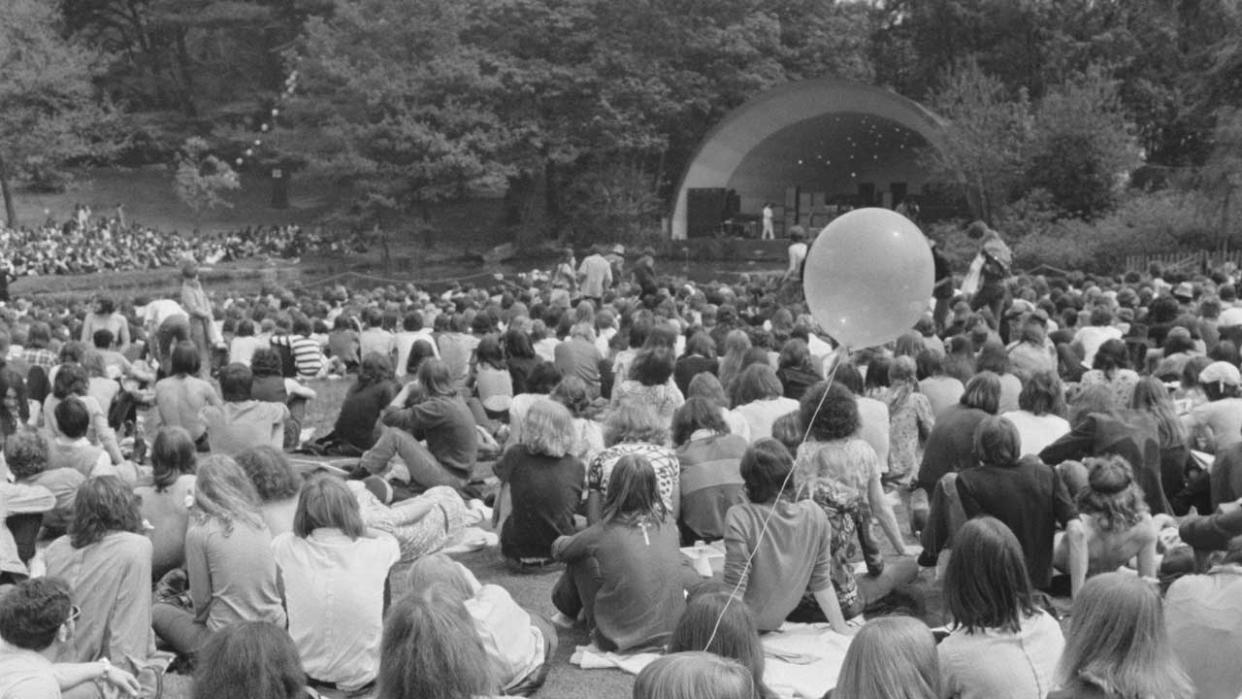In 1971 Pink Floyd played a show at Crystal Palace in London. Hundreds of fish died as a result

In 1971, after a decade dedicated to classical music, the suits at the Greater London Council decided to hand over their illustrious Crystal Palace Bowl venue to the kids.
The Bowl was unlike anything else in London. A curved concrete structure housing a stage bordering a small lake – with the audience ideally seated on the other side of the water – it would go on to host shows by everyone from Bob Marley to The Pixies before eventually falling into disrepair and being replaced in 1997.
The change in programming was prompted by an ambitious young promotor named Harvey Goldsmith, who would go on to become one of the biggest names in the business, putting together the historic Live Aid show with Bob Geldof in 1985. But in 1971 it was The Garden Party, an event designed to capitalise on the feelgood summer vibes of the Woodstock and Isle Of Wight festivals, but more conveniently located in a city, with decent public transport links.
Quiver – who later morphed into Sutherland Brothers & Quiver and became a success in the world of soft rock – opened the event, while sets from American guests Mountain, The Faces and Pink Floyd followed. And with the Floyd being the Floyd – their iconic performance in Pompeii was a few short months away – the band wanted the event to be unlike any other.
So they hired an Octopus.
It wasn't a regular octopus. This was Octopus, an inflatable structure with 25-metre-long tentacles, originally commissioned to mark the opening of Stichting Octopus, an exhibition held at the Stedelijk Museum in Amsterdam in 1968. When inflated, the octopus would gradually rise, head first, before its eight legs would slowly unfurl. For the Garden Party, this mighty rubber beast would emerge from the lake at the climax of Floyd's set, much to the delight/surprise/horror of the audience. What could possibly go wrong?
Quite a lot, as it happens.
It was a hot day, with the kind of stifling city heat that prompts New Yorkers to assault their fire hydrants. In Crystal Palace, no such vandalism was necessary, as the audience had a lake, so they entered the water, where they frolicked amongst the tentacles, causing Octopus no end of damage. Floyd's crew attempted to inflate the forlorn creature, reportedly setting off sulphur flares under the water in the process, but the damage had been done. The octopus was dead, its tentacles flaccid and head limp.
And so were the lake's fish. If they weren't killed by the flares, or by Pink Floyd's mighty quadrophonic PA system – the band premiered The Return Of The Sun Of Nothing during the set – they were already dead from the audience's joyful misuse of the lake. To add to the apocalyptic scenes, torrential rain arrived just after the band hit the stage, and the crowd split into two factions: those who fled to seek shelter, and those who realised they were already as wet as they could be, and joined the throng in the water as dead fish rose grimly to the surface.
Drummer Nick Mason remembers the event a little differently, claiming in his 2011 book Inside Out: A Personal History of Pink Floyd that the octopus "came rearing out from the lake." He did go on admit that "the moment would have been improved if a number of over-enthusiastic and mind-altered fans had not stripped off and taken to the water."
"In scenes reminiscent of Twenty Thousand Leagues Under The Sea," he continued, rather dramatically, "these lunatics got tangled with the air pipes and threatened to spoil the performance by thoughtlessly drowning."
As for the Greater London Council, who had enabled the fiasco, they reacted in the way that only local government can; by billing Pink Floyd for the cost of replacing the fish and restoring the lake to its former glory.

